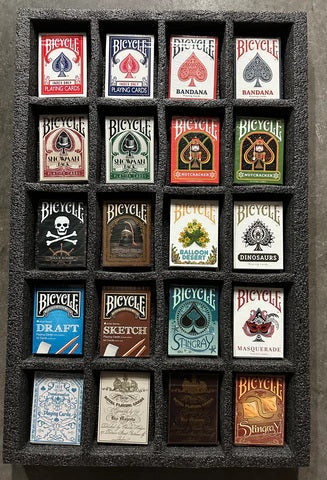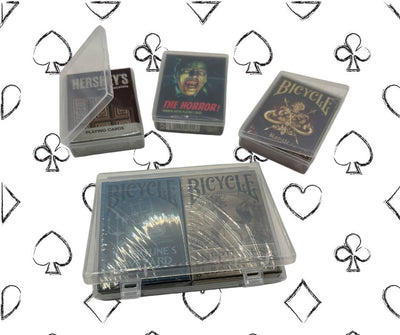Modern cardistry: what is it?
Most readers will already know what cardistry is. But for the benefit of those somewhat unfamiliar with the concept, cardistry is often described as juggling with playing cards. It's the fastest growing art-form involving playing cards, and has experienced huge growth in the past decade. The term is derived by combining the words "card" and "artistry", which is what cardistry is all about. It involves flourishing playing cards in an aesthetically pleasing display, which can happen by spins, aerials, cuts, and a whole range of other skilful moves.The idea itself is not entirely new. Already in the 1800s when card magic was popularized, it was common for magicians to demonstrate their skill with cards by adding card flourishes to their routines. Even today many magicians are good at cardistry, and it can be a way to enhance a performance. But cardistry is something altogether different from sleight of hand card magic, even though it can be used to augment it. It's a separate art-form that is a performance art of its own, which focuses on creativity, and often involves a high degree of skill. And it need not even be performed for others, because for most cardists there's reward simply in mastering a complicated move, and in enjoying the process of manipulating cards in a pleasing way.
The current cardistry boom
As an independent art form, cardistry has really come into its own over the last ten years, and enjoyed tremendous popularity. As evidence that it has evolved into an independent and legitimate modern art form is the annual Cardistry Con, which is an international convention for cardists. This has been held annually since 2014, and attracts hundreds of cardists from all over the world.Further proof lies in the many channels and forums devoted to card flourishing. These are constantly buzzing with discussions, and videos are regularly shared and admired by card flourishing enthusiasts on social media platforms like Instagram and Youtube. The number of subscribers that are part of the cardistry subforum on Reddit are a good illustration of this significant upward trend in subscribers. This subreddit came into operation around 2012, and by early 2019 had gained around 45,000 subscribers. Over the last two years alone this number has practically doubled, and is now close to 90,000.
In addition, some cardists have become quite famous, even managing to build a career founded almost entirely on their achievements with cardistry. Magician twins Dan and Dave Buck are a prime example of this kind of success. While strictly speaking the roots of cardistry do go back further than the modern era, the Buck twins are considered by many to be the fathers of cardistry, due to the tremendous influence of their cardistry tutorials and their involvement with card flourishing. The success of Dan and Dave's "Art of Play" brand is directly linked to their success with cardistry, and even now they continue to produce luxury cardistry decks on a regular basis.
Other cardists like Zach Mueller, the man behind the tremendously successful Fontaine brand of playing cards, have also been able to generate a very comfortable income in a similar way. The income generated by his brand is a six digit figure, and is almost entirely the result of combining viral cardistry videos with some clever business management and a line of brand-name decks. Besides Fontaines, there are many other brands of playing cards that are targeted entirely to cardists, and the fact that the market can support this is proof positive of a significant demand in this sector.
The single biggest factor that has enabled all this to happen is the internet. The cardistry movement has especially thrived with the help of social media, which allows people around the world to connect easily and to share new moves and ideas. Improved video technology has been a significant factor as well. Most people today have smartphones that give them access to sophisticated video cameras they can use to film their cardistry, edit and supplement it with music, and then easily share it courtesy of high speed internet connections. As a result, cardistry has seen a rapid development that would simply have been impossible and unimaginable in a pre-internet age.
An increased demand for quality decks
And that brings us to the impact of cardistry on the playing card industry. At its most basic level, cardistry has the very simplest of requirements: all you need is a deck of playing cards. The growth of cardistry has witnessed a corresponding increase in the demand for playing cards, but playing cards don't last forever. Paper is the key component used to manufacture decent playing cards that are suited to card flourishing, and that means that a typical deck of playing cards used by cardists is a consumable. All decks of playing cards will wear out eventually, but the intense demands of the flourishing actions of cardistry means that playing cards will wear out quicker than ever. It's not unheard of for a dedicated cardists to go through a brand new deck in little more than a couple of days. Not only are more people buying playing cards as a result of the popularity of cardistry, but each of them is also buying more new playing cards on a regular basis.Along with the increased demand for playing cards, comes a demand for increased quality. Due to the kinds of moves that card flourishers engage in, cardistry requires its own benchmark, which will typically be much higher than what is needed for a deck of cards used in a casual card game. Since cardistry is all about the manipulation of playing cards, the most essential requirement has to do with handling and performance. Even if you're using a dull looking deck of playing cards, you want your cards to fan and spread consistently, and you want to be able to rely on your playing cards to perform well.
As a result, cardists are rightly very fussy about the playing cards they use. This isn't just about being picky, but it's all about performance. Many cardists like their playing cards to be very soft and supple, and this has led to the popularity of "thin crush stock" from printing companies like USPCC, and the softer decks that have been produced in recent years by Cartamundi. You absolutely must have a decent deck to enjoy cardistry, and while this won't break the bank, because even a standard Bicycle rider-back deck will do the job just fine, it's really not worth wasting your time with a low quality deck from the dollar store.
A new demand for cardistry specific decks
But the evolution of cardistry has also had a big impact on the design of playing cards. With a new art form comes the demand for new equipment. Since card flourishing is all about visual aesthetics, it was only to be expected to see this visual emphasis reflected in the looks of new custom playing cards appearing on the market. As a result we've witnessed an ever-growing amount of decks designed purely to look good for card flourishing. Some of these decks are so far removed from the traditional deck of playing cards, that you wouldn't actually want to ever play an actual game of cards with them. But they often have borders that lend themselves well to fans and spreads, and incorporate designs that are emphasized with cuts, spins, pivots, and twirls, and eye-catching colours and patterns.As a result, today the playing card market is experiencing an explosion of new decks created specifically for card flourishing. One of the best known examples of a cardistry deck is the popular series created by the Singapore-based cardistry group The Virts. Their Virtuoso decks are often regarded as the world's first deck of playing cards specifically designed for cardistry, and have spawned a range of copycats and spin-offs. Everything about the graphic design was optimized for use in cardistry, and to maximize the visual impact of different flourishes. The Virts were initially uncertain how their ground-breaking cardistry deck would be received. But its subsequent tremendous success and the ongoing demand for more decks like it have proved beyond a doubt that the cardistry community was large enough to support the creation and production of custom decks made exclusively to be used for cardistry.
As a standard part of their promotion and marketing, Kickstarter projects for new cardistry decks typically include promotional videos of cardists using their decks. And it works. Today a growing number of young cardists are happy to throw money at projects and creators that will keep feeding them with creative custom decks, and good cardistry decks can be genuine money-makers. Many popular cardistry brands specialize in creating luxury decks for cardists, and the demand for them only continues to grow, especially as creators come up with new ideas. Clearly we are at a new juncture in the playing card industry, where the cardistry deck has become a viable sub-genre of its own. It was a natural development for cardistry to employ playing cards with aesthetics that visually accent every card flourish, and that are even designed purely with this in mind. And there are enough cardists to make it viable.
An evolution towards non-standard cards
But as the cardistry deck continued to evolve, it would be inevitable that playing cards would move even further away from their original purpose in playing card games. At the extreme end of this trend are the School of Cardistry decks from the New Deck Order. The New Deck Order was formed in 2013 by well-known cardist Jaspas Deck (real name Justin Ye) and Loretta Sze. Their web-site aimed to be a portal for bringing together cardistry fans from around the world, and was combined with a popular youtube channel, School of Cardistry, which provided free instructional videos on cardistry.In 2014, the New Deck Order team took the cardistry deck to the next level, by producing something that went much further than the cardistry decks that had preceded them. They took their starting point in the fact that a traditional deck of playing cards has one big limitation that until now had not been overcome, namely the need for 52 different faces. You need these for playing card games, but these different faces are arguably an obstacle for aesthetics, no matter how they are designed. So why not abandon the idea of having 52 different cards altogether? How about completely doing away with the idea of a traditional deck, and make the cards ideal for cardistry - back and front?!
So they created a deck intended from the ground up to be used simply for card flourishing. And in the process they birthed what they described as a new standard for cardistry: non-standard playing cards. With these non-standard decks, playing cards have arrived at a point where they have not been before. Until that point, cardistry decks still included traditional suits and values on all the cards, even though optimizing their designs for cardistry in a creative and colourful fashion often made them quite unsuitable for playing a card game or performing card magic. But now the cardistry deck had arrived at a new place altogether, by consisting of 52 completely identical cards, front and back.
This was truly something designed purely for cardistry, and was further removed from the original purpose of a deck of traditional playing cards than ever before! The evolution of the playing card deck was now truly at an unparalleled point in its history, moving yet another step further away from its originally designed purpose as a gaming tool, and now turning it into a tool of choice for an entirely new game: cardistry.
Ongoing evolution and new ideas
Cardistry is rapidly maturing as an art form, but it continues to evolve. As new enthusiasts join the fast-moving bandwagon of cardistry, they bring their own ideas to the table, and come up with new moves and showcase new concepts. Those on the cutting edge of cardistry are regularly producing stunning videos of things that we've never seen before. And the beauty is that it's a creative art that even a complete unknown can jump into, coming up with some original moves and concepts that leave old-timers in awe of the craft and ingenuity required.It's no surprise that alongside this constantly evolving discipline we're seeing an evolution in custom playing cards, to help meet the existing demand from cardists, and to open up new possibilities. Besides the non-standard decks shown above, all of which remove values and pips entirely, there's also a list of hybrid cardistry decks, which still retain indices in some form, as a nod to tradition, but have the same repeating shape or image on every face. Examples of popular decks of this sort include the award-winning Echo deck from cardistry brand Lotusinhand, which features a circular target on all the card faces and backs, and the ground-breaking ArrowDynamix deck, which features arrows pointing in different directions on both sides of the cards.
In recent years we've seen a growing variety of custom card flourishing decks appear on the market. We've seen innovative decks that have different artwork on the front and on the back of each and every card. We've seen decks designed to be used in tandem with an ultraviolet light. With cardistry, suddenly nothing is standard anymore. Anything is fair game, and deck designs and ideas are limited only by your imagination. These are good times to be alive!
Final thoughts
Clearly we haven't yet seen everything that cardistry has to offer. The future promises new and exciting flourishes from new and exciting talent - some of whom are yet to discover the joy of cardistry, and whom we'll only meet in the next decade. But with the help of social media and online videos, they will eventually discover and explore cardistry, emerge onto the public stage, and make their own contributions to this growing art form.But besides new talent, the future also promises new tools for this burgeoning art, as creators think of new things to do with playing cards, and new designs for the cards themselves. It may take us further away from playing cards as tools for playing card games. But if it brings us to new forms of artistry, I'm all for it!
About the writer: EndersGame is a well-known and respected reviewer of board games and playing cards. He loves card games, card magic, cardistry, and card collecting, and has reviewed several hundred boardgames and hundreds of different decks of playing cards. You can see a complete list of his game reviews here, and his playing card reviews here. He is considered an authority on playing cards and has written extensively about their design, history, and function, and has many contacts within the playing card and board game industries. You can view his previous articles about playing cards here. In his spare time he also volunteers with local youth to teach them the art of cardistry and card magic.





